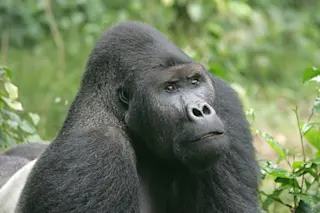A male gorilla named Ciminuka at Kahuzi-Biega National Park in 2005. (Credit: Graueri Gorilla/Wikipedia) For the first time in 20 years, wildlife biologists conducted a comprehensive population survey of the Grauer's gorilla, the largest primate in the world. What they found confirmed their worst fears: In the time since the last gorilla census was taken in 1994, their population declined by an estimated 77 percent. The researchers estimate that there are only some 3,800 Grauer's gorillas left in their native habitat in the Democratic Republic of the Congo, which has been wracked with human conflict for the past two decades.
Researchers from the Wildlife Conservation Society finally gained access to the DRC in 2011, and recently published the results of a four-year study estimating the number of gorillas that remain in the country. Grauer's gorillas inhabit some of the most remote regions of the jungle, and researchers combined observational recordings ...














